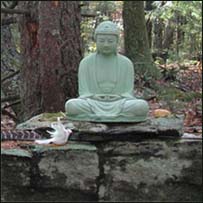|
|
 |
Please support Dharma Seed with a 2025 year-end gift.
Your donations allow us to offer these teachings online to all.

|

|

|
The greatest gift is the
gift of the teachings
|
|

|
| |
|
Dharma Talks
|
2025-11-02
Der Dhammaweg, Teil II
47:50
|
|
Renate Seifarth
|
|
|
Im weiteren geht es um die nächsten Bereiche des achtfachen Pfades, nämlich rechte Absicht, wofür ein Erkennen unserer Absicht hinter unseren Handlungen gehört. Wissensklarheit ist ein wichtiges Instrument dafür, das wir in der Vipassanapraxis entwickeln. Unsere Absichten führen zu entsprechenden Handeln, als erstes auf der gedanklichen Ebene, dann wie wir handeln und sprechen, ob privat oder beruflich. Für Buddha sind das wesentliche Aspekte unseres Dhammaweges.
|
|
Seminarhaus Engl
:
Vipassana und Karuna Retreat
|
|
|
2025-10-31
Der Dhammaweg, Teil I
48:04
|
|
Renate Seifarth
|
|
|
Zunächst werden die vier Wahrheiten dargestellt, die uns vier Aufgaben präsentieren. Hierbei geht es vor allem um dukkha, einer komplexen vielschichtigen Gegebenheit in unserem Leben, die für den Buddha der Mittelpunkt seiner Lehre bildet. Es gilt dukkha zu überwinden. Buddha beschreibt dazu einen achtfachen Pfad, den wir Schritt für Schritt gehen können. Der erste Bereich ist rechte Sichtweise. Dazu gehören all unsere Konzepte, Vorstellungen, Ansichten, Meinungen über die Welt und über einen Weg zu Glück.
|
|
Seminarhaus Engl
:
Vipassana und Karuna Retreat
|
|
|
2025-10-30
Transition From Settling to Seeing (Retreat at Spirit Rock)
1:49:25
|
|
Tere Abdala-Romano
|
|
|
This talk explores the gentle transition from shamatha (calm abiding through concentration) to vipassanā (insight), inviting us to cultivate stillness not through effort but through nourishment, (as The Budha did) curiosity, and kindness. It reminds us that the mind’s obstacles—dullness and agitation—are gateways to balance and presence. From this grounded calm, clarity naturally arises, revealing the truth of impermanence, unsatisfactoriness, and non-self. In resting with things as they are, stillness ripens into seeing, and seeing reveals freedom.
|
|
Spirit Rock Meditation Center
:
Settling, Seeing, and Spacious Awareness (276R25)
|
|
|
2025-10-30
Instructions from My Teachers
40:12
|
|
James Baraz
|
|
|
We all have teachers who've inspired us to see life in a new way. Who have been your inspirations?
What have you learned from them? I thought I'd share some ways that instructions from two of my
teachers--Ram Dass and HWL Poonja (Papaji)-- have shaped how I see the world and how I practice.
The talk includes a recording of a significant dialogue from 1990 with Poonjaji that reconnected me
with my joy.
Here is a link to the dialogue of the Poonjaji satsang where James asked the question
https://docs.google.com/document/d/16TnL2Zev-6r_mZPrgdSxSTaYLoyzdLOg3CnJ2U3D6C8/edit?tab=t.0
Here is a link to the video on Youtube that is over an hour long
https://www.youtube.com/watch?v=MrjspK5fHiQ. James is at 23:38
|
|
Insight Meditation Community of Berkeley
|
|
|
|
|